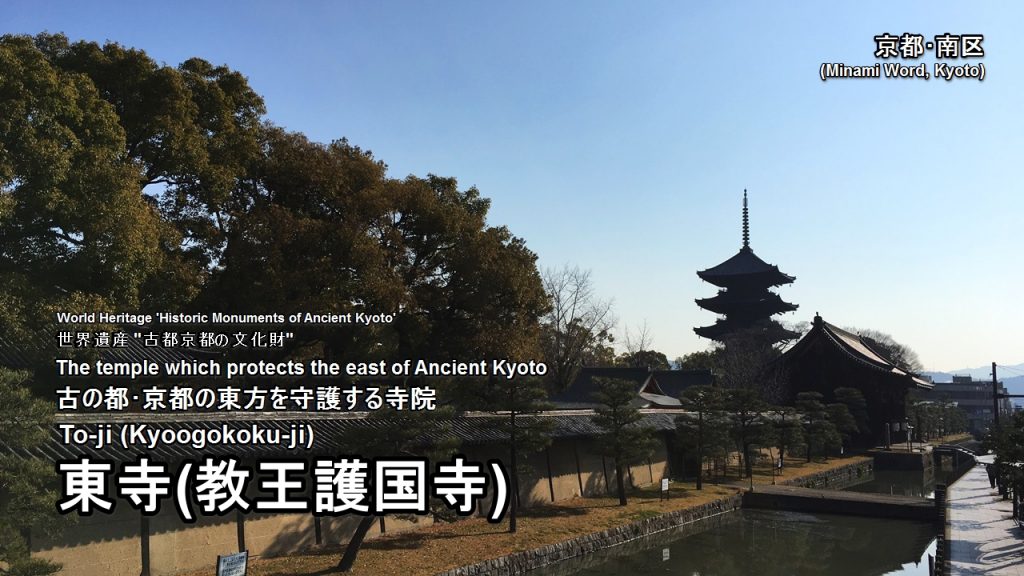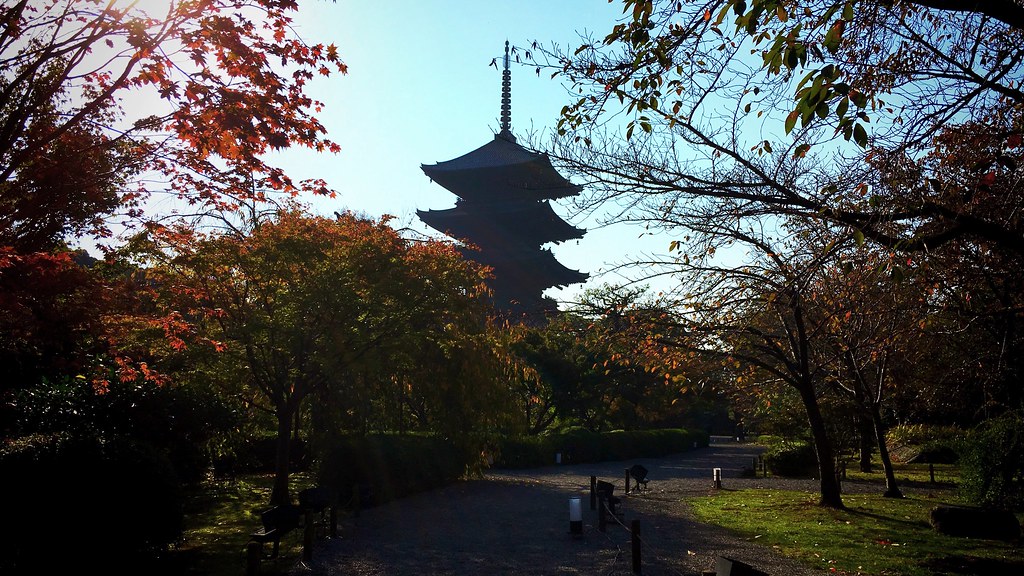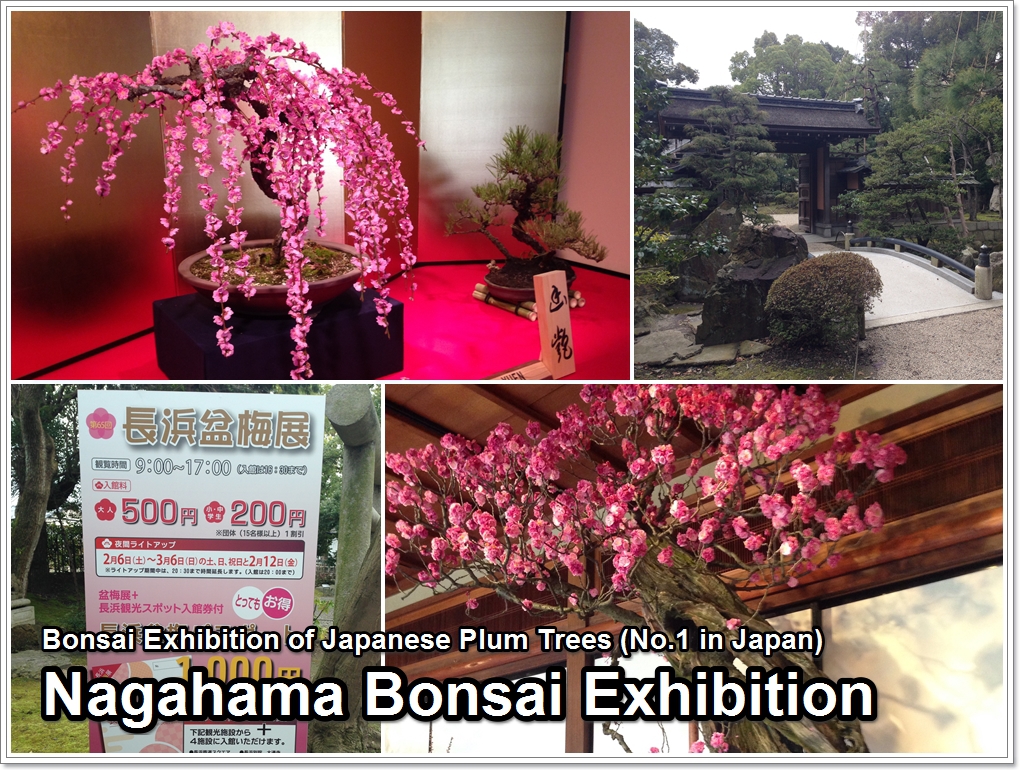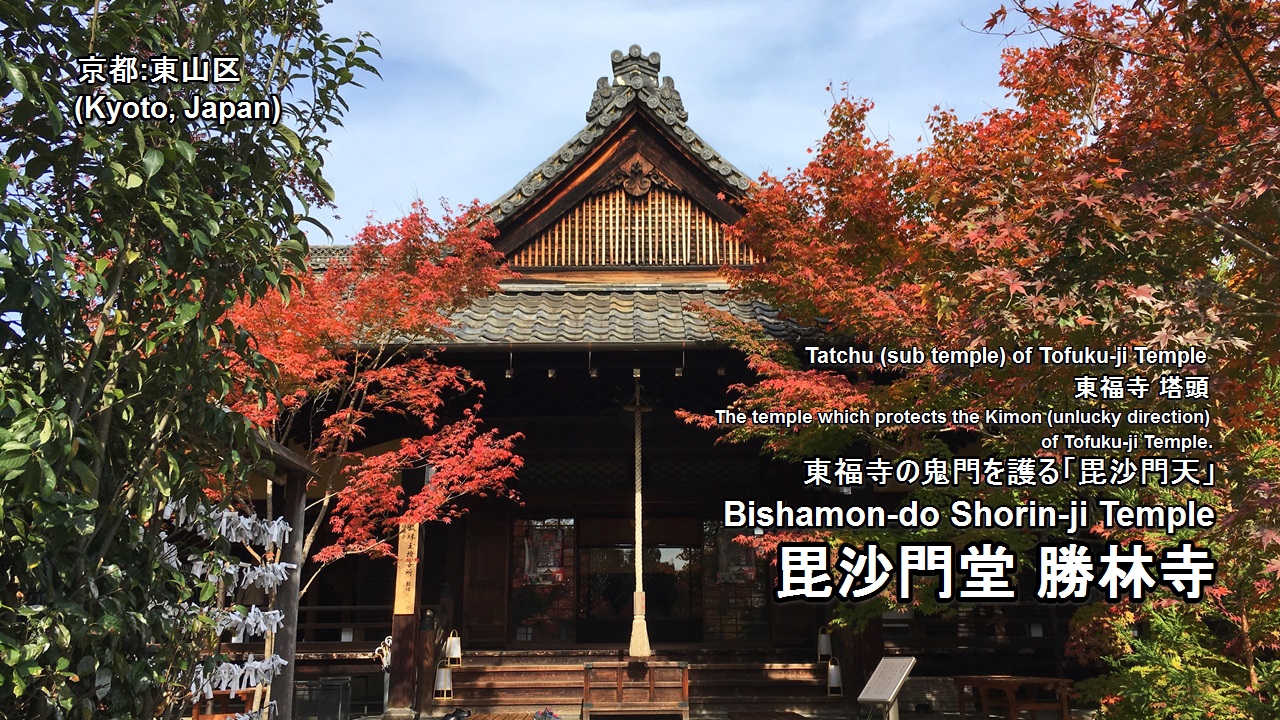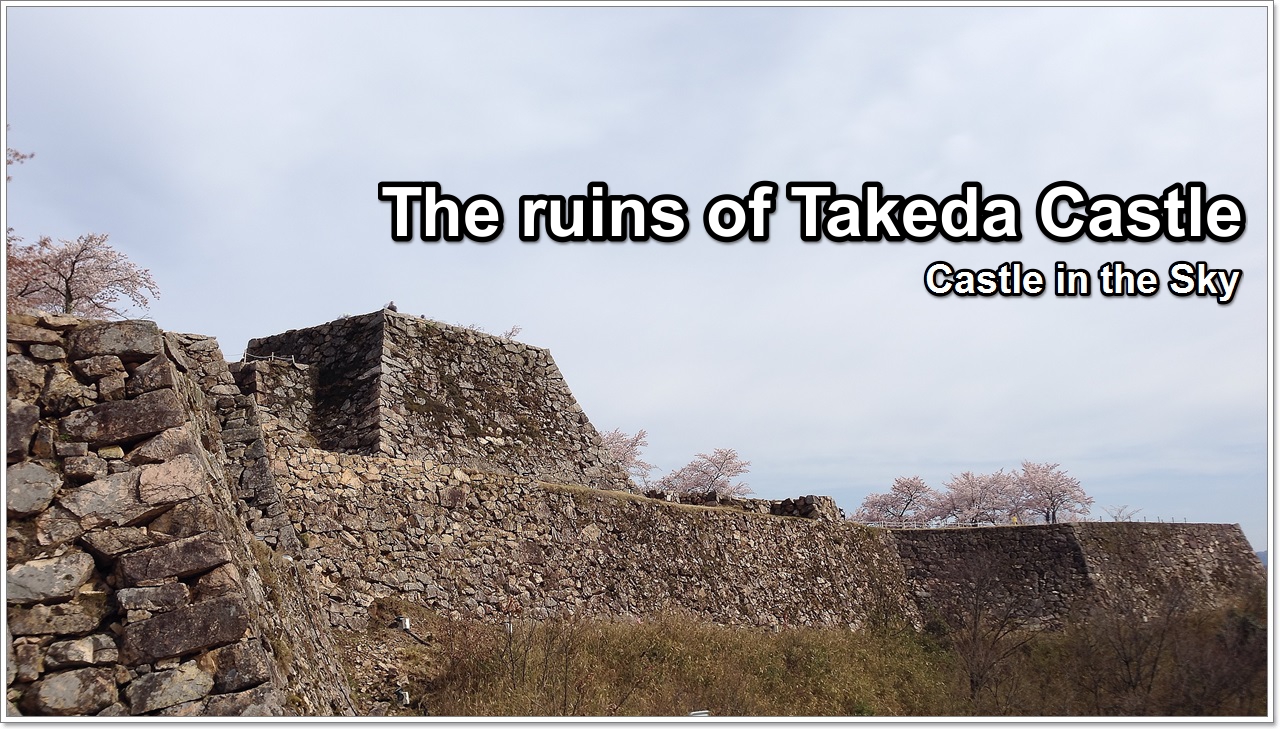To-ji Temple(東寺), located in Kujo-cho, Minami Ward, Kyoto, is the head temple of the To-ji Shingon Sect that has relations to Kobo Daishi Kukai.
In addition, this temple is built in 796 of the Heian period and has the history more than 1200 years.
It is also famous for the 5-Story Pagoda which we can watch from the Shinkansen.
This temple has two names, ‘To-ji(東寺)‘ and ‘Kyoogokoku-ji(教王護国寺)‘, and the official name as the religious organization is ‘Kyoogokoku-ji(教王護国寺)‘.
“Kyoo(教王)” refers to the edification of the king, and the name of “Kyoogokoku-ji(教王護国寺)” has connotations of an esoteric Buddhism temple that is the guardian temple of the nation.
This temple’s precincts have been designated as a national historic site.
In addition, it has been designated as the Michelin green guide ★★ and the World Heritage List as part of the ‘Historic Monuments of Ancient Kyoto’.
Contents:
- World Heritage ‘Historic Monuments of Ancient Kyoto
- History of To-ji Temple
- About To-ji Temple
- Visitor Information
- Highlights of To-ji Temple
- Photos of To-ji Temple
- Goshuin of To-ji Temple
- How to get to To-ji Temple
- Hotel search & reservation around To-ji Temple
1.World Heritage ‘Historic Monuments of Ancient Kyoto
17 places of temples and shrines of Kyoto are designated in the ‘Historic Monuments of Ancient Kyoto’.
↓Details of the “Historic Monuments of Ancient Kyoto” is here.↓
To-ji Temple has been designated as the World Heritage List as part of the ‘Historic Monuments of Ancient Kyoto’.
2.History of To-ji Temple
Let’s study the history of this temple with me before introducing To-ji Temple.
I think that we can enjoy the sightseeing of To-ji Temple more by learning the history of this temple.(○´艸`)
To-ji(東寺) means the ‘East temple’ in Japanese.
(‘東‘ means ‘East‘, ‘西‘ means ‘West‘, ‘南‘ means ‘South‘, ‘北‘ means ‘North‘.)
Then, are there temples named ‘West Temple’, ‘North Temple’ and ‘South Temple’ in Kyoto?
At first, there are no ‘North Temple’ and ‘South Temple’ in Kyoto.
In Japan, the sunrise and the sunset were thought that these are important things very much from old days.
Therefore, the east side and the west side came as an object of the protection in particular.
Even in Nara, there are ‘East Temple(東大寺(Todai-ji))‘ and ‘West Temple(西大寺(Saidai-ji))‘, but there are no ‘North Temple’ and ‘South Temple’.
Then, what about the ‘West Temple’?
In fact, there was ‘West Temple(Sai-ji Temple)(西寺)’ in Kyoto in the old days.
However, it disappeared for a reason.
Kyoto was a capital of Japan and, in the old days, was called ‘Heian-kyo(平安京)‘.
And it had the big gate which is the entrance of the capital called Rajo-mon gate(羅城門).
(This gate was not repaired after being ruined by a destructive storm in 980, and only a stone monument is left in its place.)
And, Sai-ji Temple, and To-ji Temple which still exists today, were built at the west and east guardians’ positions of the Rajomon gate.
(Sai-ji Temple and To-ji Temple are thought to have been of approximately the same size.)
Therefore the To-ji Temple is built in the south side in comparison with other famous temples of Kyoto.
And Emperor Saga(嵯峨天皇) granted To-ji Temple to Kukai(空海) and simultaneously granted Sai-ji Temple to Shubin(守敏) in 823.
Both Kukai and Shubin were a monk in the early Heian period(平安時代).
And Kukai is, of course, the founder of Shingon Buddhism(真言宗).
It seems that Kukai and Shubin did not get along with each other.
Although Shubin had been known as a famous Buddhist monk for offering prayers, In the case of the drought of 824, because Shubin lost to Kukai in a ceremony of praying for rain, Sai-ji temple is thought to have gone into decline as Shubin, grew weaker.
In comparison with it, Kukai garnered many believers as belief in Kobo Daishi(弘法大師).
Since the middle ages To-ji has flourished with the support of nobles and statesmen such as Emperor Gouda(後宇多天皇), Emperor Godaigo(後醍醐天皇), and Takauji ASHIKAGA(足利尊氏).
And it was flourished as the central training center of Shingon Esoteric Buddhism(真言密教).
An influence of the act of praying for rain was very big in Japan…!!
*Some sentences are adapted story.
3.About To-ji Temple
Tō-ji (東寺 Tō-ji) (East Temple) is a Buddhist temple of the Shingon sect in Kyoto, Japan. It once had a partner, Sai-ji (West Temple) and, together, they stood alongside the Rashomon, gate to the Heian capital. It was formally known as Kyō-ō-gokoku-ji (教王護国寺 The Temple for the Defense of the Nation by Means of the King of Doctrines?)[1] which indicates that it previously functioned as a temple providing protection for the nation. Tō-ji is located in Minami-ku near the intersection of Ōmiya Street and Kujō Street, southwest of Kyoto Station.
引用(citation):https://en.wikipedia.org/wiki/T%C5%8D-ji
Open:5:00-17:00(Visit to the building : 8:30~17:00)
Admission Fee:Varies according to season and buildings
Address:1, Kujocho, Minami-ku Kyoto-shi, Kyoto, 601-8473, Japan
Phone Number:+81-75-691-3325
Foundation:796
Founder:Emperor Kanmu(桓武天皇)
宗派:To-ji Shingon Sect(東寺真言宗)
ご本尊:Yakushi Nyorai(Bhaisajyaguru:薬師如来)
To-ji Temple(東寺), located in Kujo-cho, Minami Ward, Kyoto, is the head temple of the To-ji Shingon Sect that has relations to Kobo Daishi Kukai.
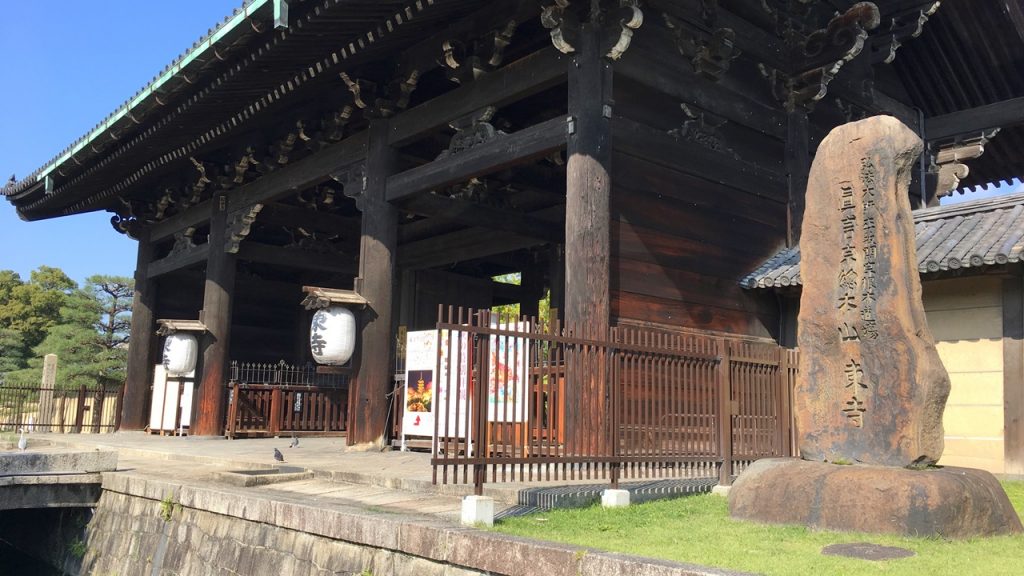
This temple’s precincts have been designated as a national historic site.
In addition, it has been designated as the Michelin green guide ★★ and the World Heritage List as part of the ‘Historic Monuments of Ancient Kyoto’.
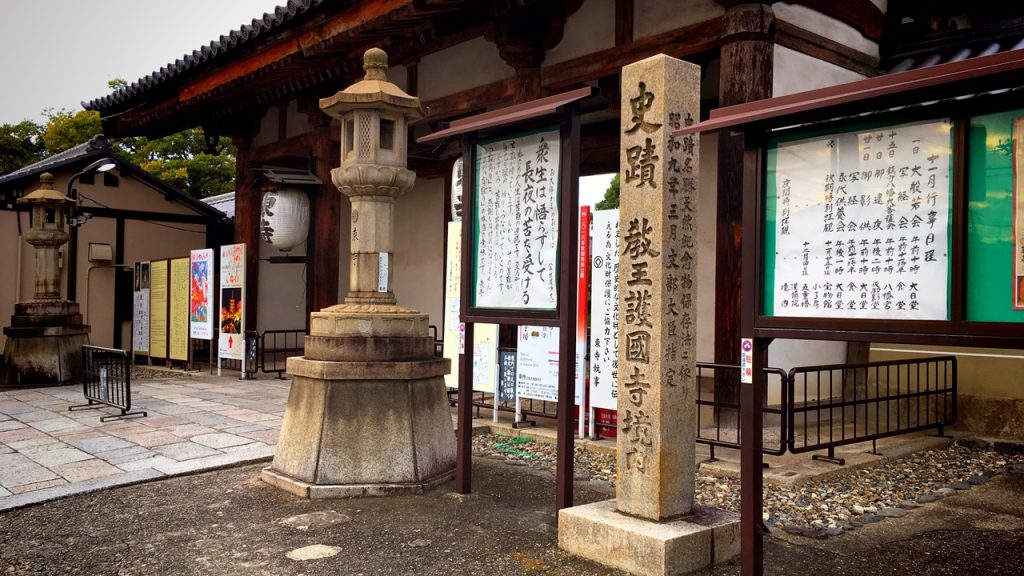
It is said that To-ji Temple was built in 796 by FUJIWARA no Isendo(藤原伊勢人) who was a court official lived towards the end of the Nara period to the early Heian period.
He was appointed to the head officer for building To-ji Temple by Emperor Kanmu(桓武天皇).
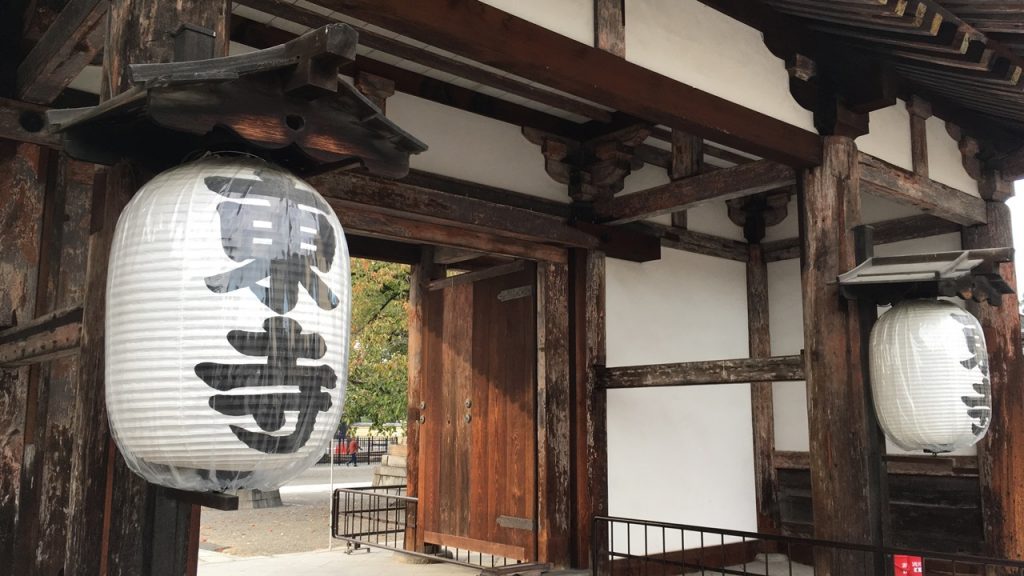
An admission fee varies according to season and buildings.
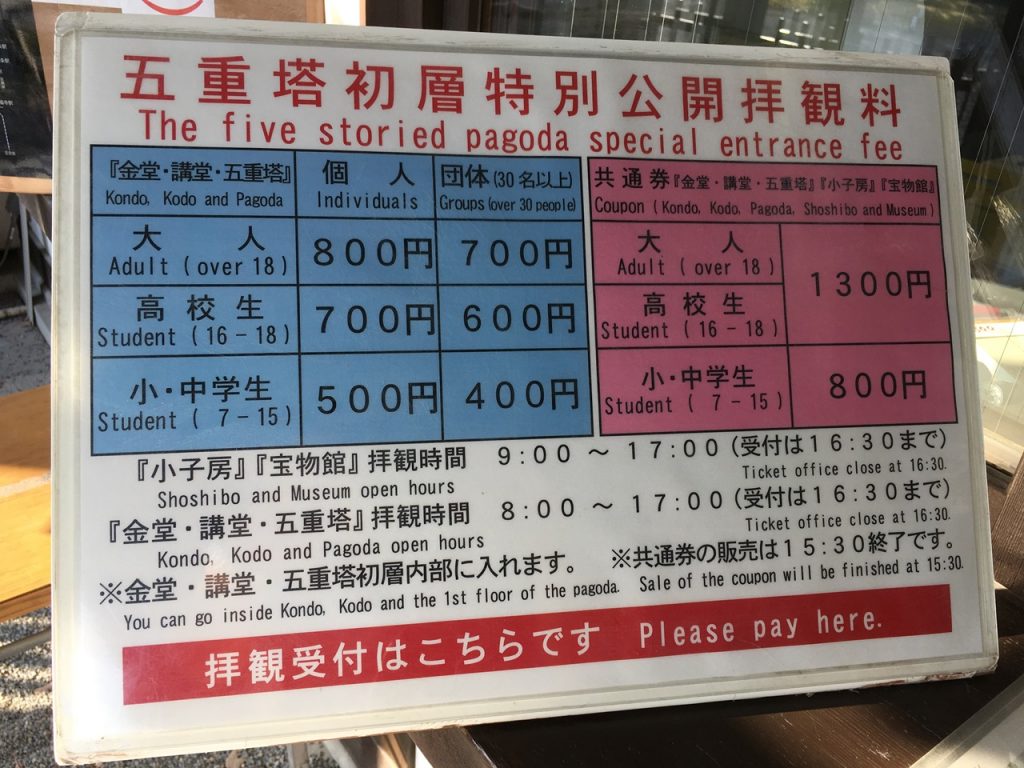
This is the panoramic view of To-ji Temple.
There is the building which we cannot enter depending on a season.

Next, let’s see the highlight of To-ji Temple!!

4.Visitor Information
・There is the building which we cannot enter depending on a season.
・Photography and video recording are prohibited inside the building of this temple.
Let’s follow a rule.
5.Highlights of To-ji Temple
- 金堂(国宝)*:Kon-do hall(National treasure)*
- 講堂(重要文化財)*:Ko-do hall(Important cultural property)*
- 五重塔(国宝)*:5-Story Pagoda(National Treasure)*
- 食堂:Jiki-do hall
- 宝蔵(重要文化財):Ho-zo(Treasure House)(Important cultural property)
- 南大門(重要文化財):Nandai-mon gate(Important cultural property)
- 北大門(重要文化財):Hokudai-mon gate(Important cultural property)
- 北総門(重要文化財):Hokuso-mon gate(Important cultural property)
- 慶賀門(重要文化財):Keiga-mon gate(Important cultural property)
- 大日堂:Dainichi-do hall
- 御影堂(国宝):Mie-do hall(National Treasure)
- 毘沙門堂:Bishamon-do hall
- 小子房*:Shoshi-bo*
- 勅使門:Chokushi-mon gate
- 蓮花門(国宝):Renge-mon gate(National Treasure)
- 潅頂院(重要文化財)*:Kanjo-in(Important Cultural Property)*
- 宝物館*:Homotsu-kan Museum*
- 太元堂:Taigen-do hall
- 弁天堂:Benten-do hall
- 鎮守八幡宮:Chinju Hachimangu Shrine
- 八島殿:Yashima-den Shrine
「*印」のついている見どころは有料エリアです。(This seal (*) is a pay area.)
●金堂(国宝)*:Kon-do hall(National treasure)*
This is the Kon-do hall rebuilt in 1603 of the Edo period(江戸時代) which is designated as a National treasure.
The original building was destroyed by ‘Tsuchi ikki(土一揆:a peasant uprising)’ which occurred in 1481 of the Muromachi period.
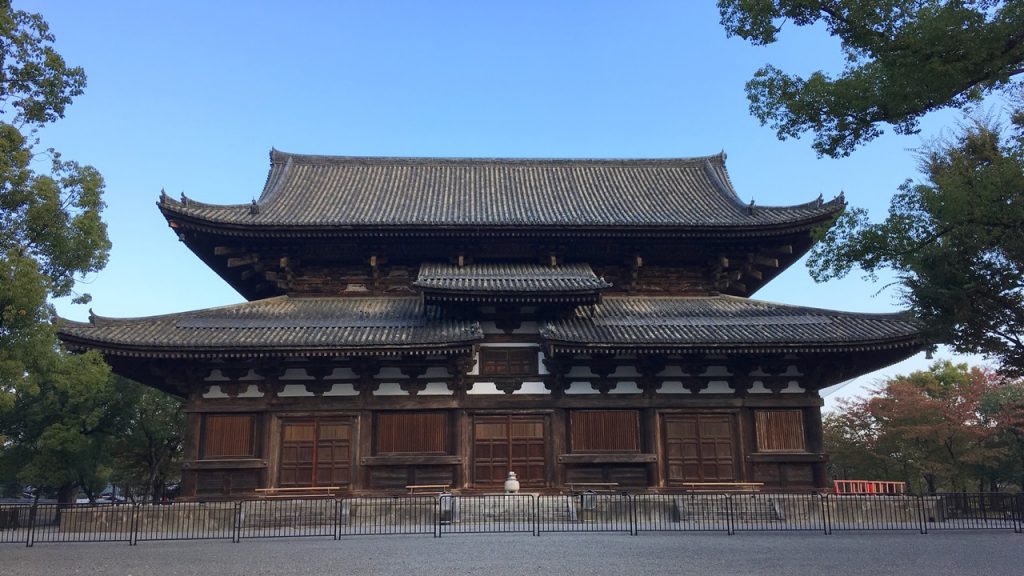
The wooden seated statue of Yakushi Nyorai(薬師如来坐像) which is the principal idol of this temple is enshrined in this building.

●講堂(重要文化財)*:Ko-do hall(Important cultural property)*
This is the Ko-do hall rebuilt in 1491 of the Muromachi Period(室町時代) which is designated as an Important cultural property.
The original building was destroyed by ‘Tsuchi ikki(土一揆:a peasant uprising)’ which occurred in 1481 of the Muromachi period.

21 Buddha statues in conjunction with the esoteric Buddhism such as Dainichinyorai(大日如来:Vairocana) are enshrined in this building.
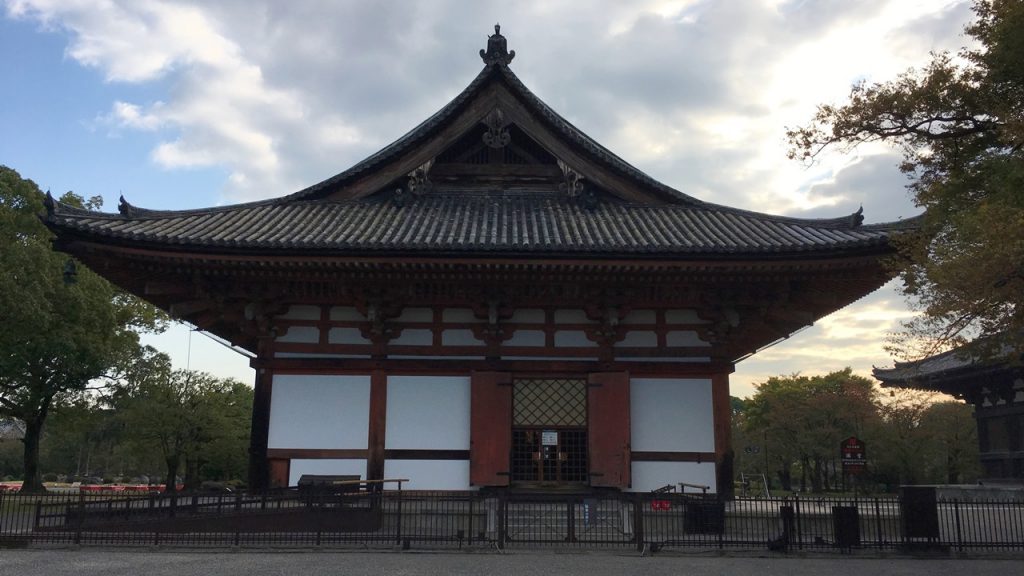
●五重塔(国宝)*:5-Story Pagoda(National Treasure)*
This is the 5-Story Pagoda rebuilt in 1644 of the Edo period(江戸時代) which is designated as a National treasure.
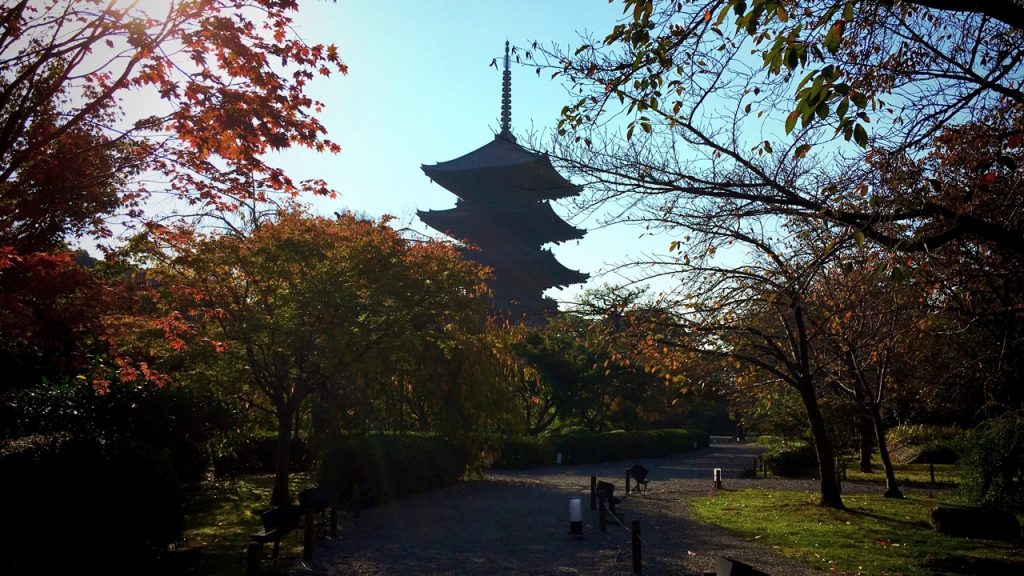
Because having burned 4 times due to causes ranging from lighting to suspicious circumstances, the current pagoda is the 5th pagoda built in 1644 with a donation from Iemitsu TOKUGAWA(徳川家光).
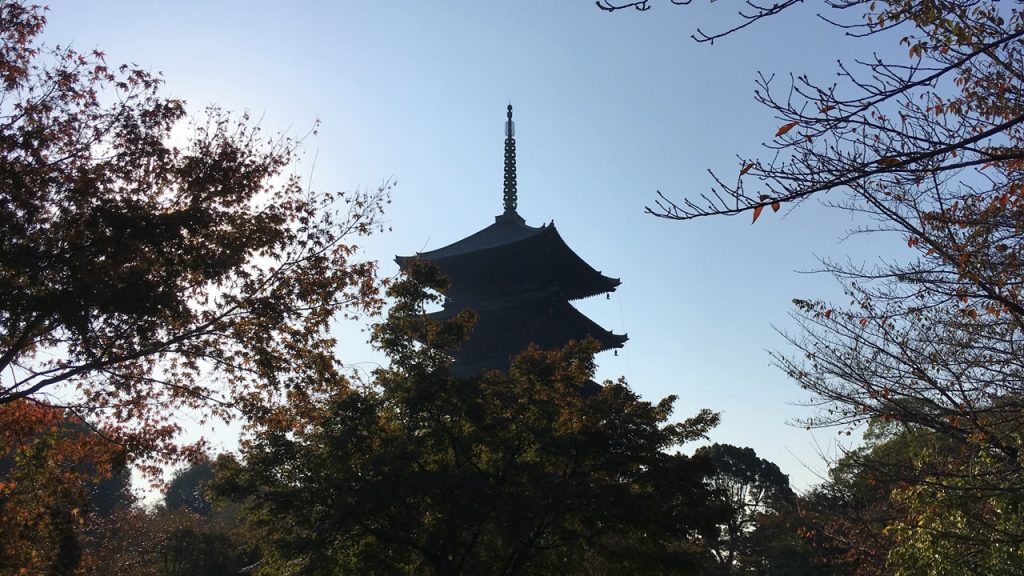
It is 54.8 meters high and the tallest wooden pagoda in Japan.
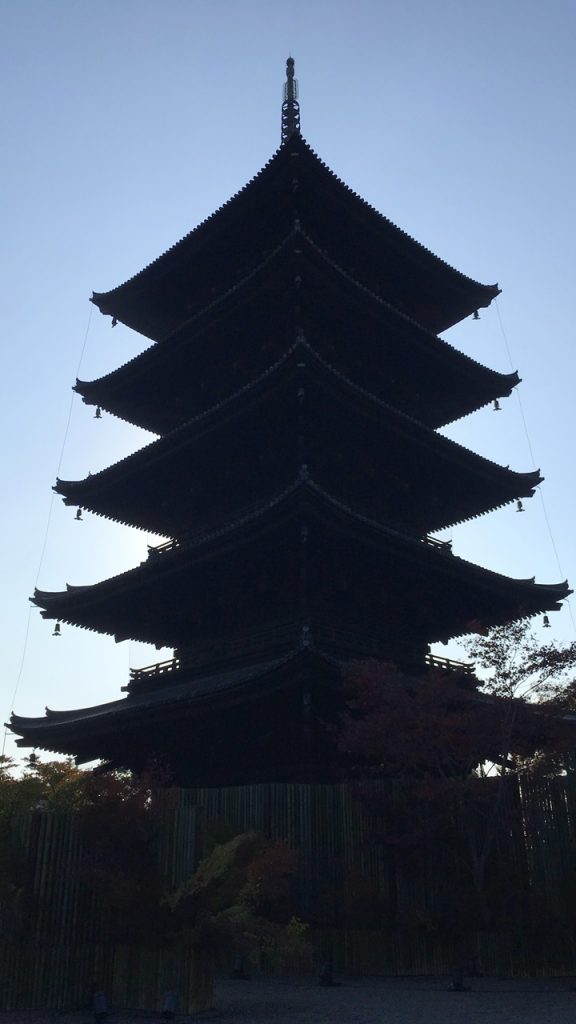
●食堂:Jiki-do hall
This is the Jiki-do hall rebuilt in 1934 of the Showa period(昭和時代).

It is also the 23th site on the Rakuyo Kannon Pilgrimage of 33 Temples in Kyoto City (洛陽三十三所観音霊場).
The statue of the Eleven-faced Kannon(十一面観音) is enshrined in this building.
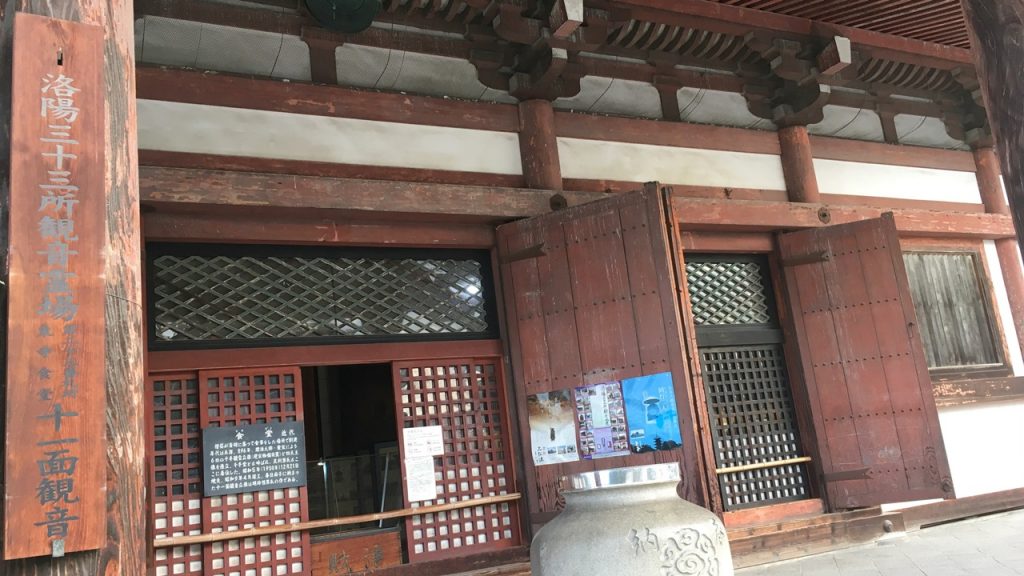
●宝蔵(重要文化財):Ho-zo(Treasure House)(Important cultural property)
This is the Ho-zo(Treasure House) built in the Heian period(平安時代) which is designated as an Important cultural property.
This building is the oldest building existing in this temple.
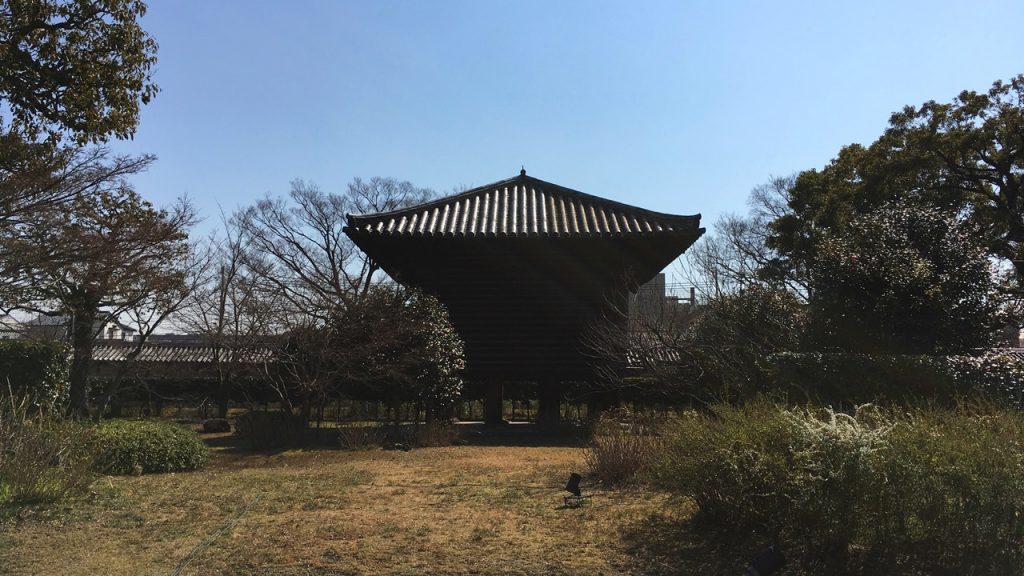
●南大門(重要文化財):Nandai-mon gate(Important cultural property)
This is the Nandai-mon gate reconstructed in 1895 of the Meiji period which is designated as an Important cultural property.

This gate was reconstructed using the west gate of Sanjusangen-do Temple(三十三間堂) built in the Momoyama period(桃山時代).
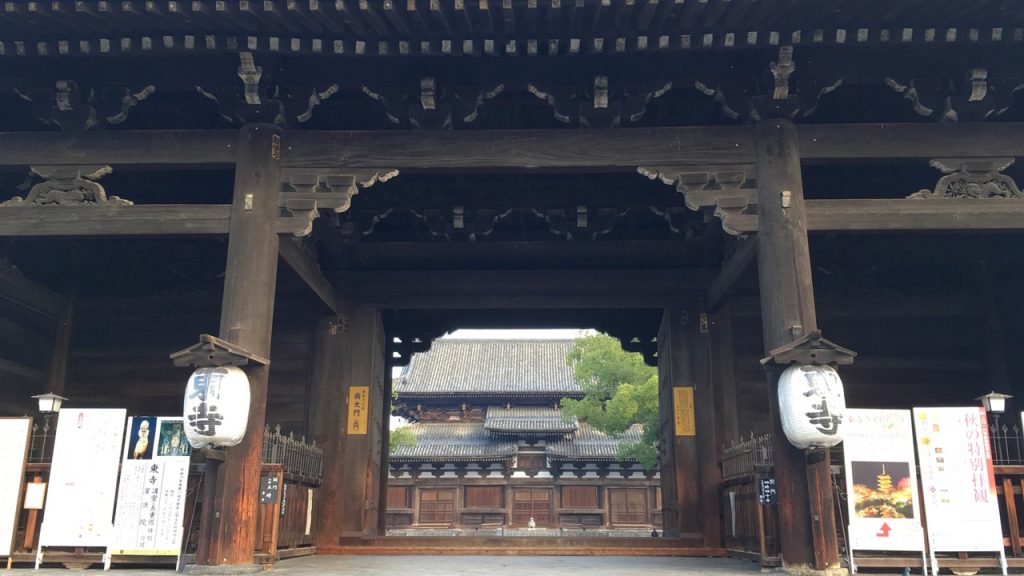
●北大門(重要文化財):Hokudai-mon gate(Important cultural property)
This is the Hokudai-mon gate built in the early Kamakura period(鎌倉時代) which is designated as an Important cultural property.
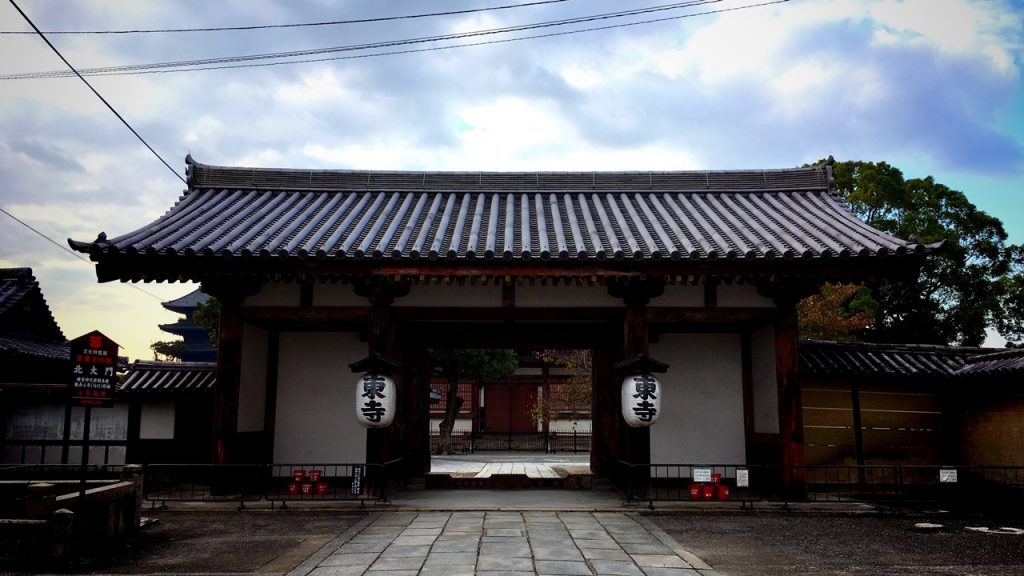
●北総門(重要文化財):Hokuso-mon gate(Important cultural property)
This is the Hokuso-mon gate built in the late Kamakura period(鎌倉時代) which is designated as an Important cultural property.
This gate is located in the northernmost area of the precincts.
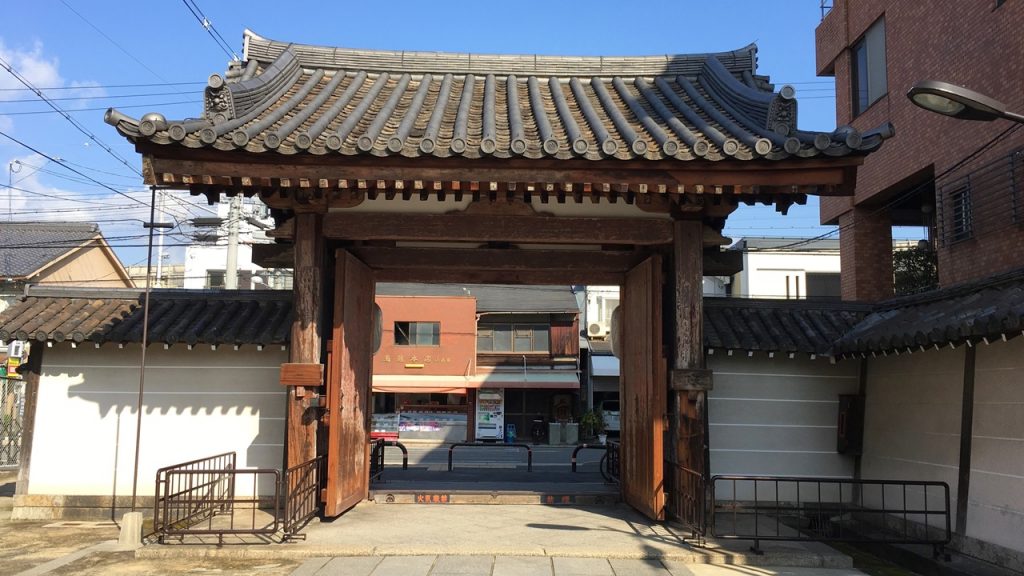
●慶賀門(重要文化財):Keiga-mon gate(Important cultural property)
This is the Keiga-mon gate built in the early Kamakura period(鎌倉時代) which is designated as an Important cultural property.
This gate has a role as a Chokushi-mon Gate(勅使門:Imperial Envoy’s Gateway).
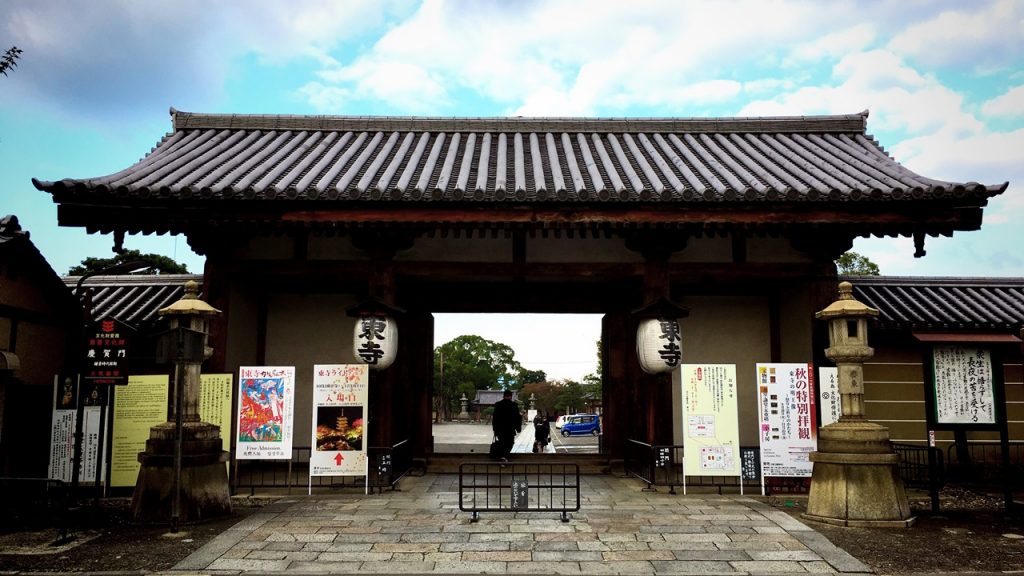
●大日堂:Dainichi-do hall
This is the Dainichi-do hall which was rebuilt in 2000.
The seated statue of Dainichi Nyorai(大日如来坐像) is enshrined in this building.
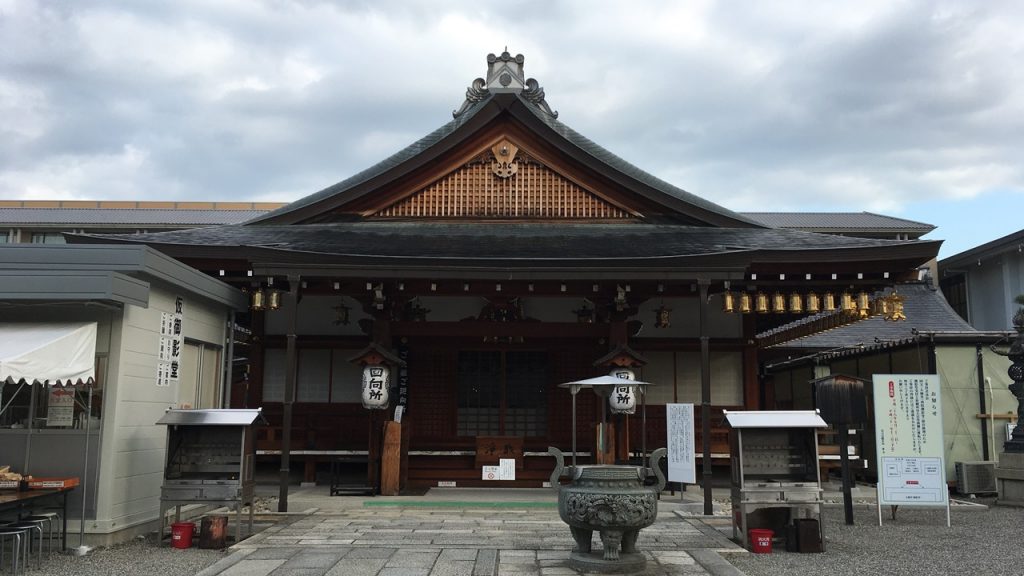
●御影堂(国宝):Mie-do hall(National Treasure)
This is the Mie-do hall rebuilt in 1380 of the Nanboku-cho period which is designated as a National treasure.
This building is during restoration construction until December, 2019.
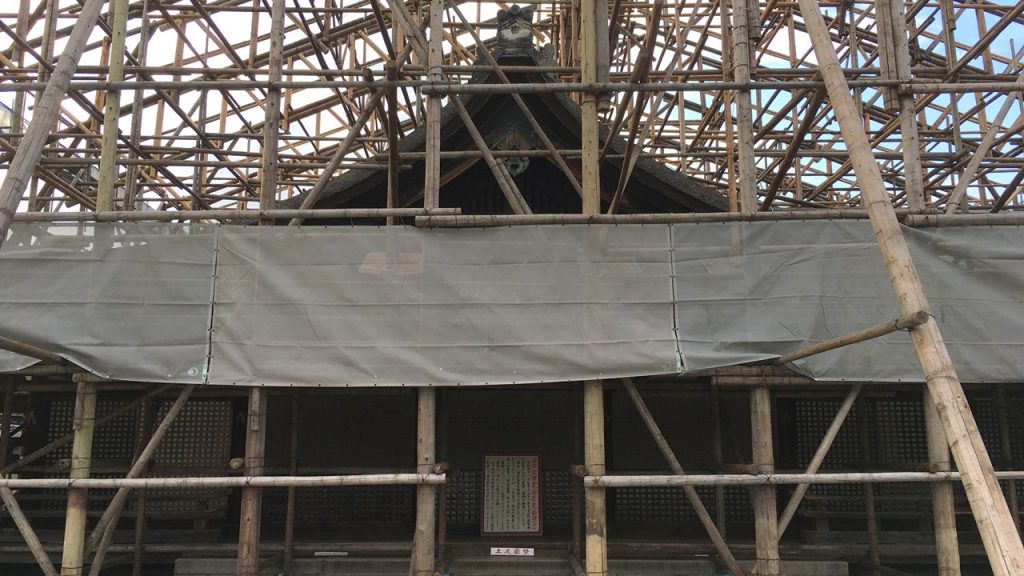
●毘沙門堂:Bishamon-do hall
This is the Bishamon-do hall rebuilt in 1823 of the Edo period(江戸時代).
The statue of Bishamonten(毘沙門天:Vaisravana) is enshrined in this building.
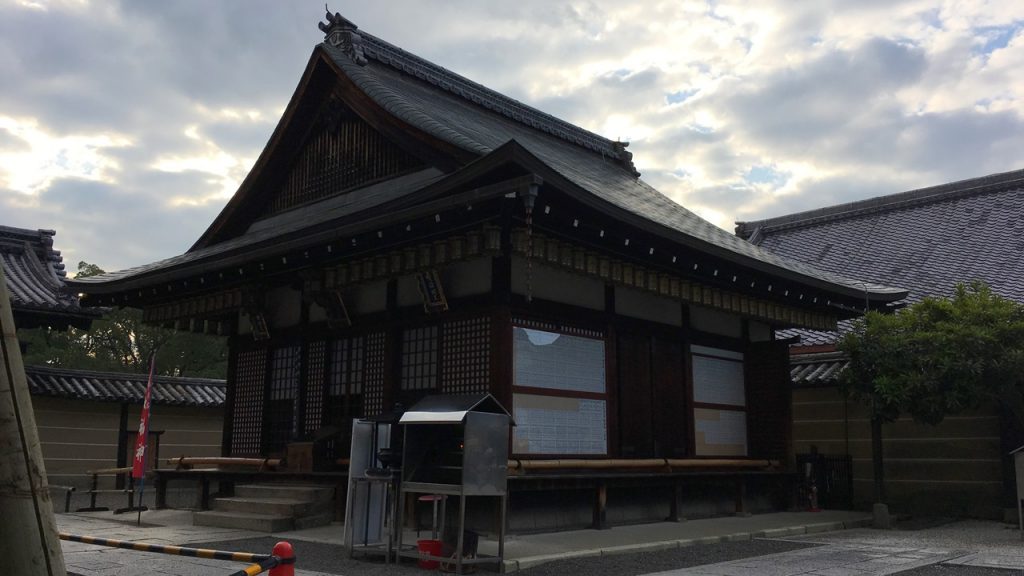
●小子房*:Shoshi-bo*
This is the Shoshi-bo rebuilt in 1934 of the Showa period(昭和時代).
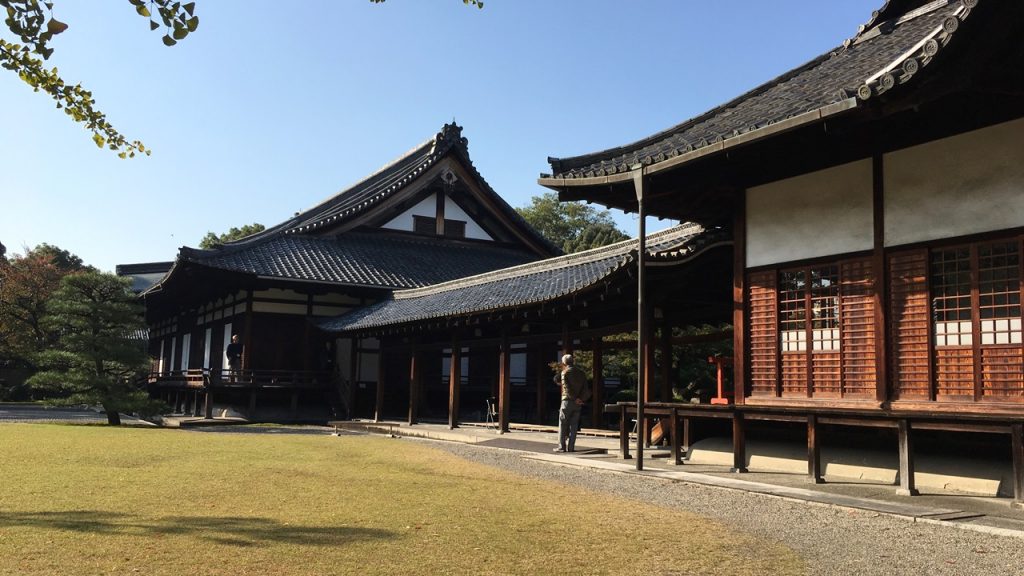
This building has a role as a Gosho(御所:Imperial Palace) when the Imperial family visit to this temple.
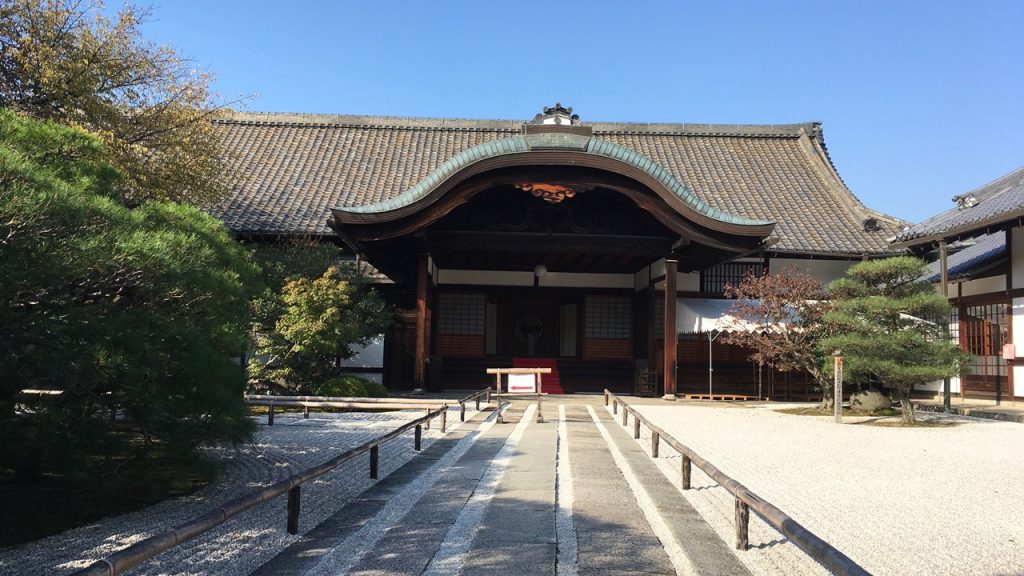
The garden of this building is called ‘Choshin-en(澄心苑)’.
‘Choshin(澄心)’ has a meaning of ‘a pure heart.’
It was designed by Ogawa Jihei VII(小川治兵衛) who was a great master of the modern Japanese garden.
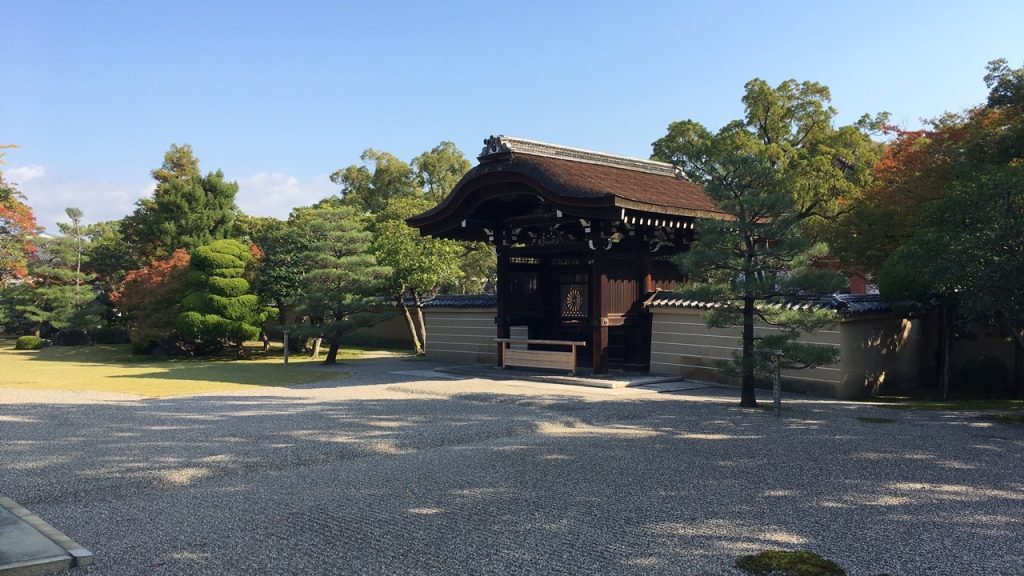
●勅使門:Chokushi-mon gate
There is the Chokushi-mon gate(勅使門) to the east of the Shoshi-bo(小子房).
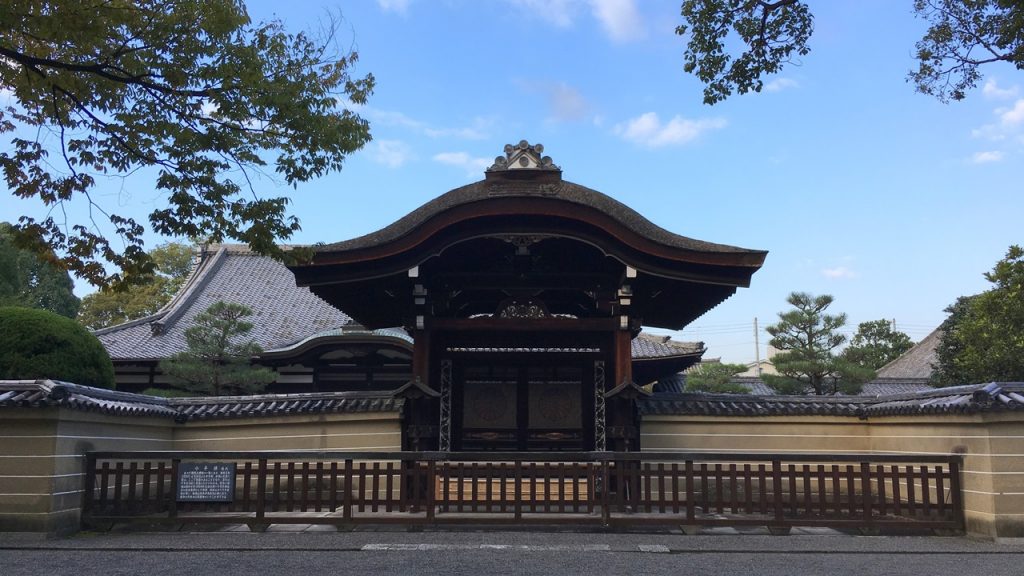
●蓮花門(国宝):Renge-mon gate(National Treasure)
There is the Renge-mon gate(蓮華門) rebuilt in the Kamakura period(鎌倉時代) which is designated as a National treasure to the west of the Shoshi-bo(小子房).

●潅頂院(重要文化財)*:Kanjo-in(Important Cultural Property)*
This is the Kanjo-in rebuilt in 1634 of the Edo period(江戸時代) which is designated as an Important cultural property.
This building was built as ascetic practices dojo studio.
Now, this building has a role as a place that holds a Buddhism ceremony.
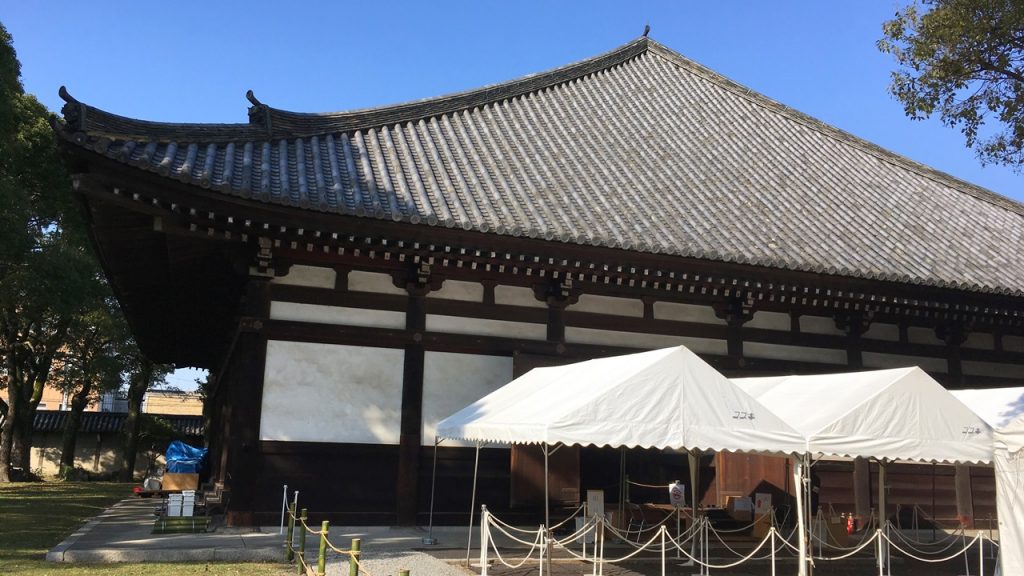
The east gate and the north gate of this building are both designated as an Important cultural property.
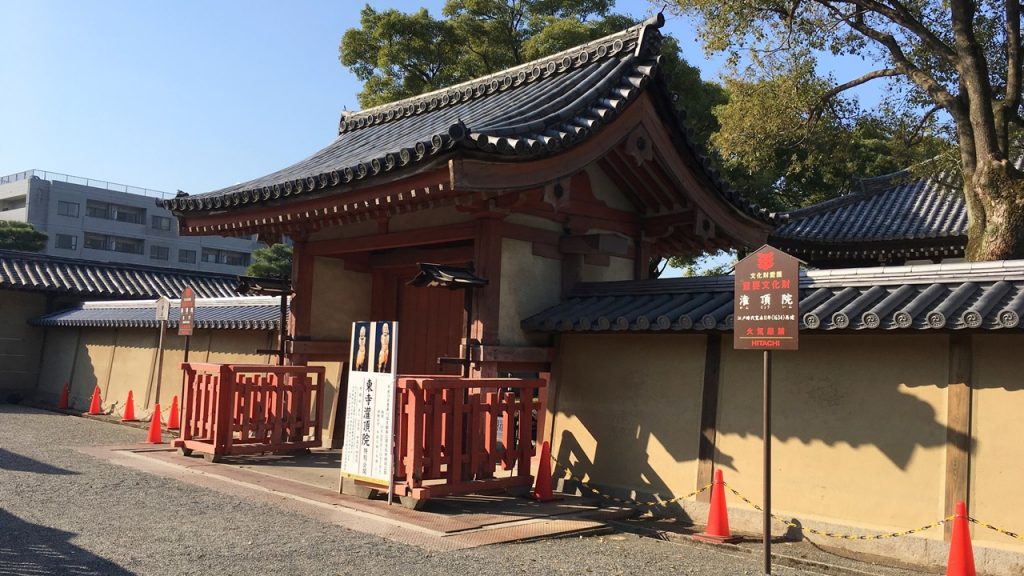
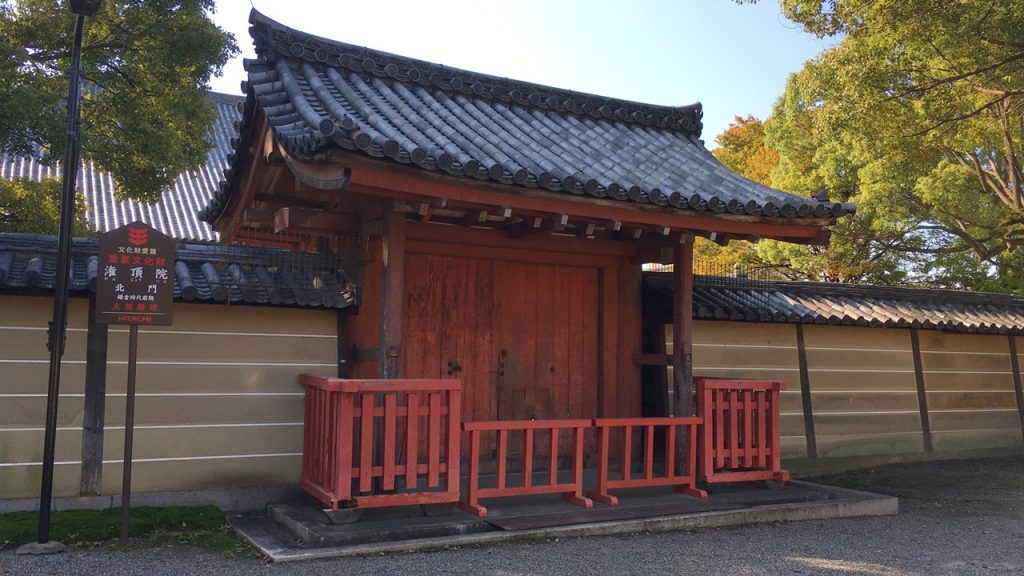
●宝物館*:Homotsu-kan Museum*
This is the Homotsu-kan Museum.
It is opened to the public in spring and autumn.
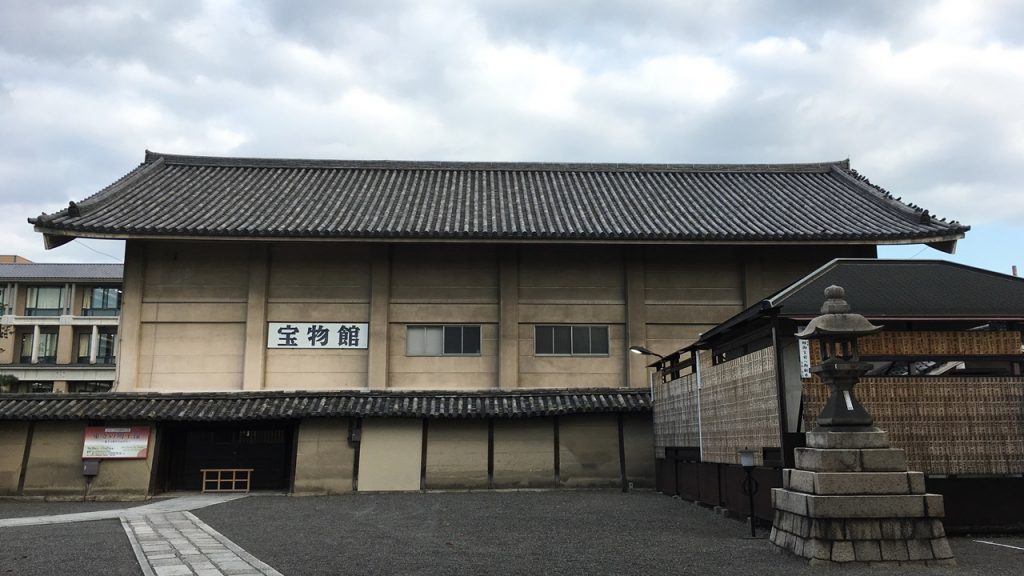
●太元堂:Taigen-do hall
This is the Taigen-do hall rebuilt in 1929 of the Showa period(昭和時代).
Daigensui Myoo(大元帥明王:Atavaka) who safeguards a peaceful nation is enshrined in this building.
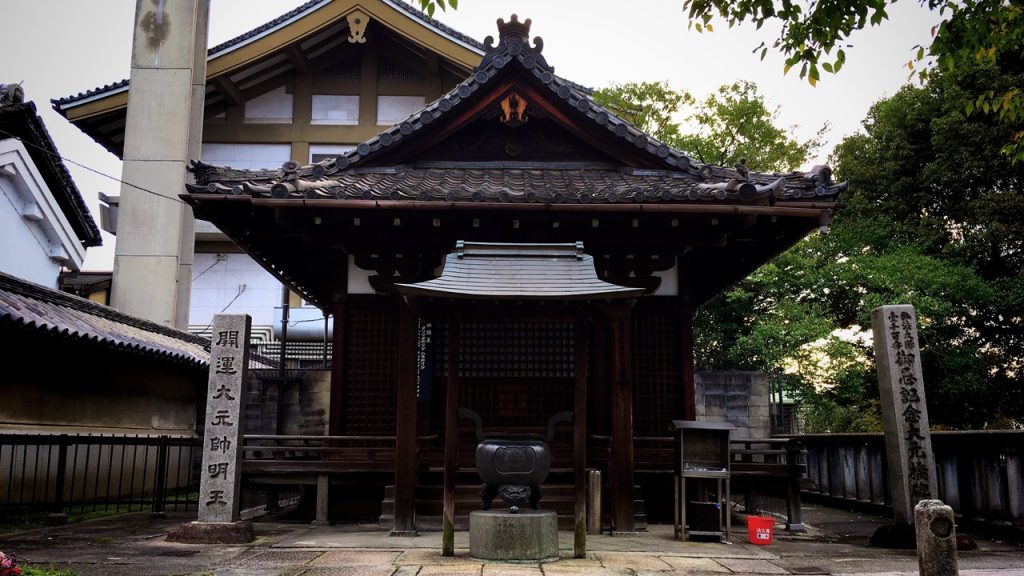
●弁天堂:Benten-do hall
This is the Benten-do hall built in the Edo period(江戸時代).
Benzaiten(弁財天) is enshrined in this building.
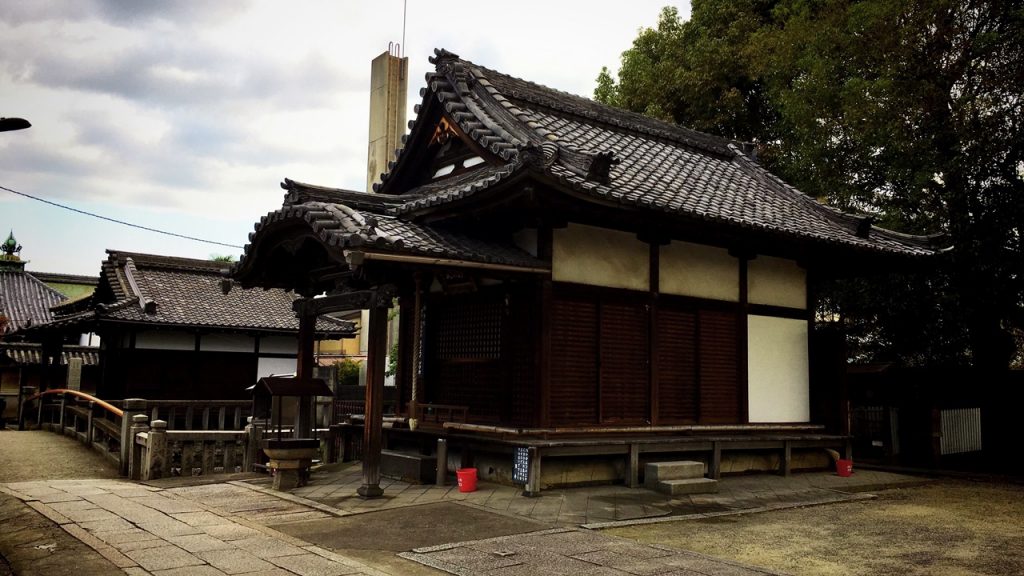
●鎮守八幡宮:Chinju Hachimangu Shrine
This is the Chinju Hachimangu Shrine rebuilt in 1992.
An image of a deity enshrined in this building is the Japanese oldest image of a deity, and it is said that that image was carved by Kukai.
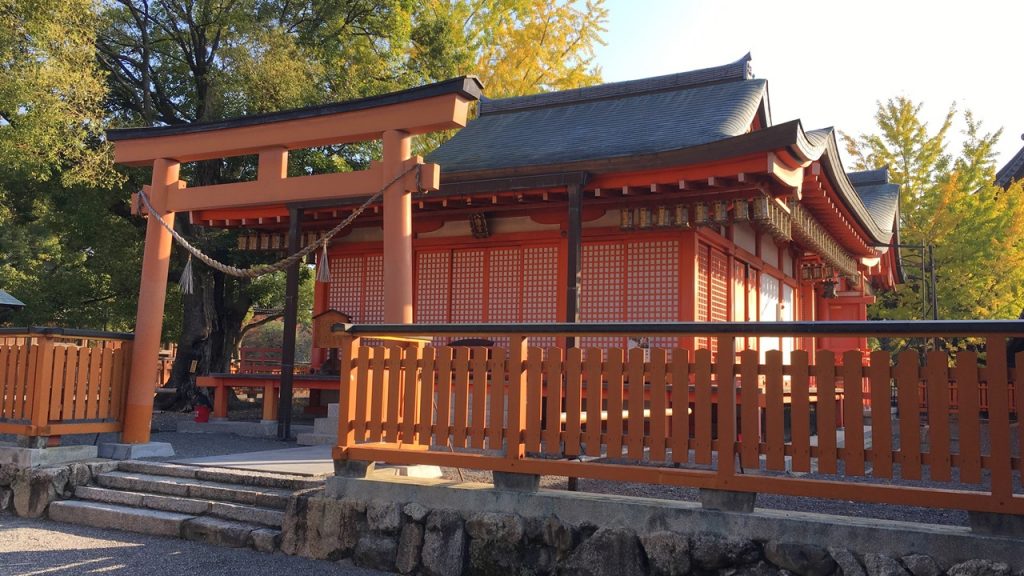
●八島殿:Yashima-den Shrine
This is the Yashima-den Shrine.
Jinushigami(地主神:the deity associated with the local area) is worshiped here.
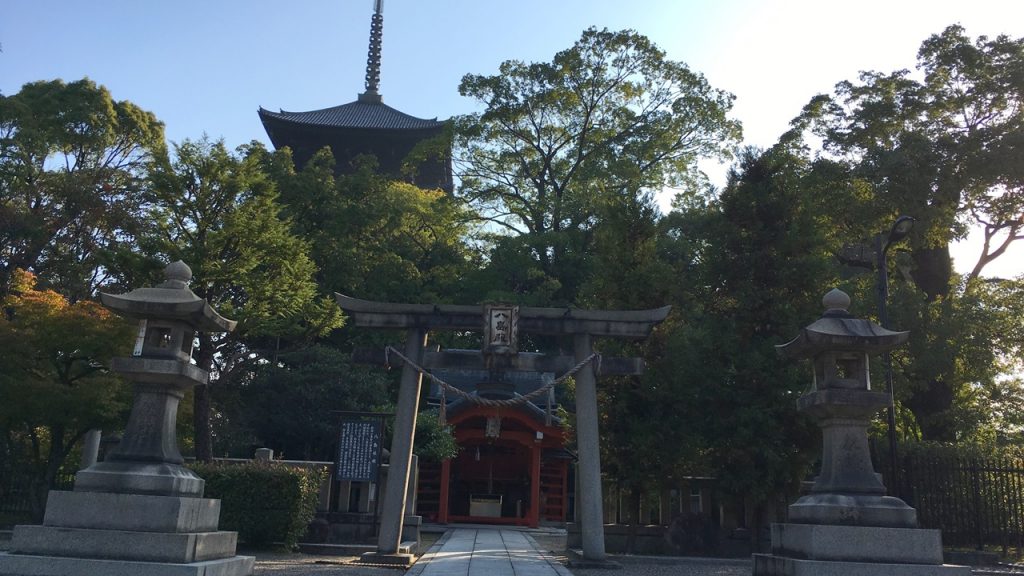
6.Photos of To-ji Temple
■Flickr:Photo of To-ji Temple (20161103)
7.Goshuin of To-ji Temple
This Temple’s Sumigaki(The words which was written with a sumi(black ink)) is “Kobo-Daishi(弘法大師)” which is the posthumous name of Kukai.
We can get this Goshuin at Jiki-do hall.
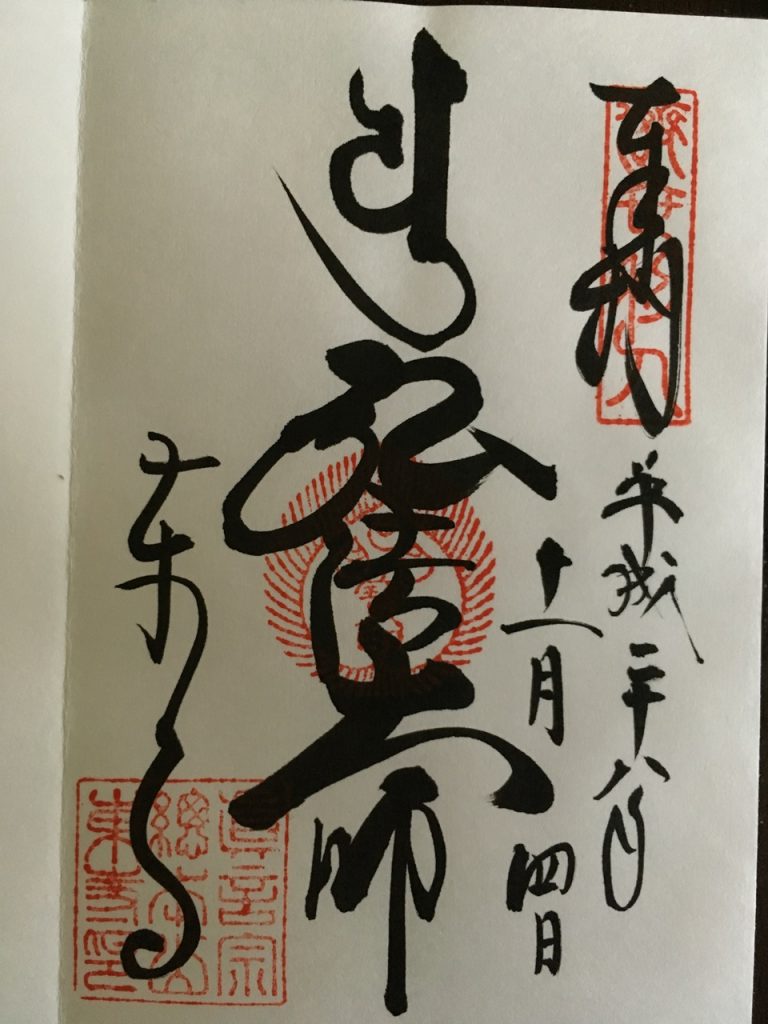
8.How to get to To-ji Temple
The nearest station of To-ji Temple is “JR Kyoto station” or “Kintetsu To-ji Station”
(We can also go by bus from “JR Kyoto Station”, “Hankyu Kawaramachi Station” and “Keihan Gion-Shijo Station”.)
■Route Example (From Osaka station to Kintetsu To-ji Station)
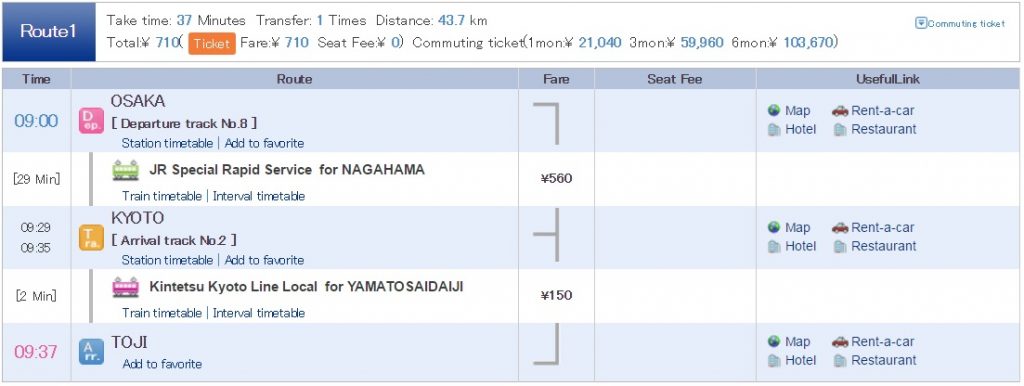
■Route Example (From Namba station to Kintetsu To-ji Station)
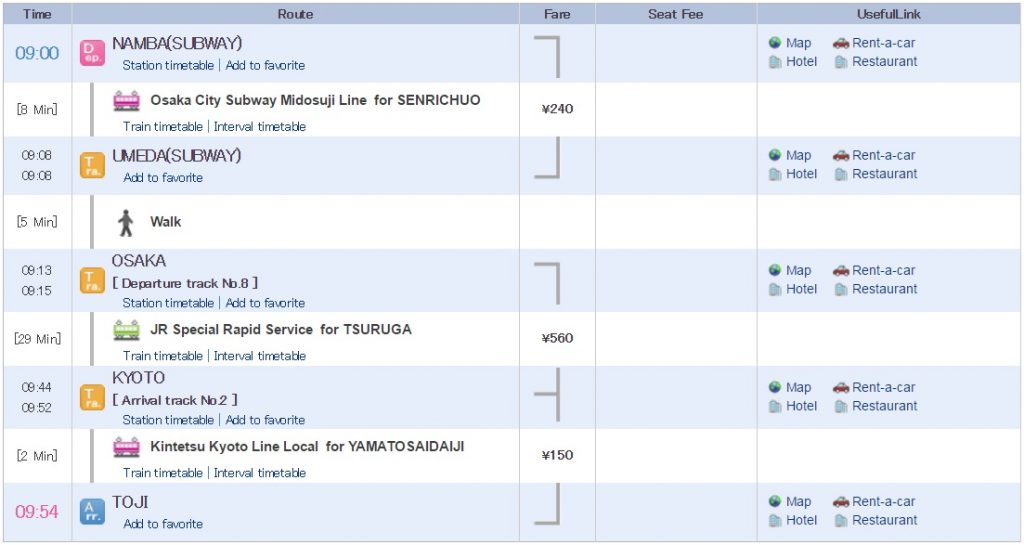
■When you go on foot from JR Kyoto Station
It’s about 20 minutes (1.2 km) on foot.
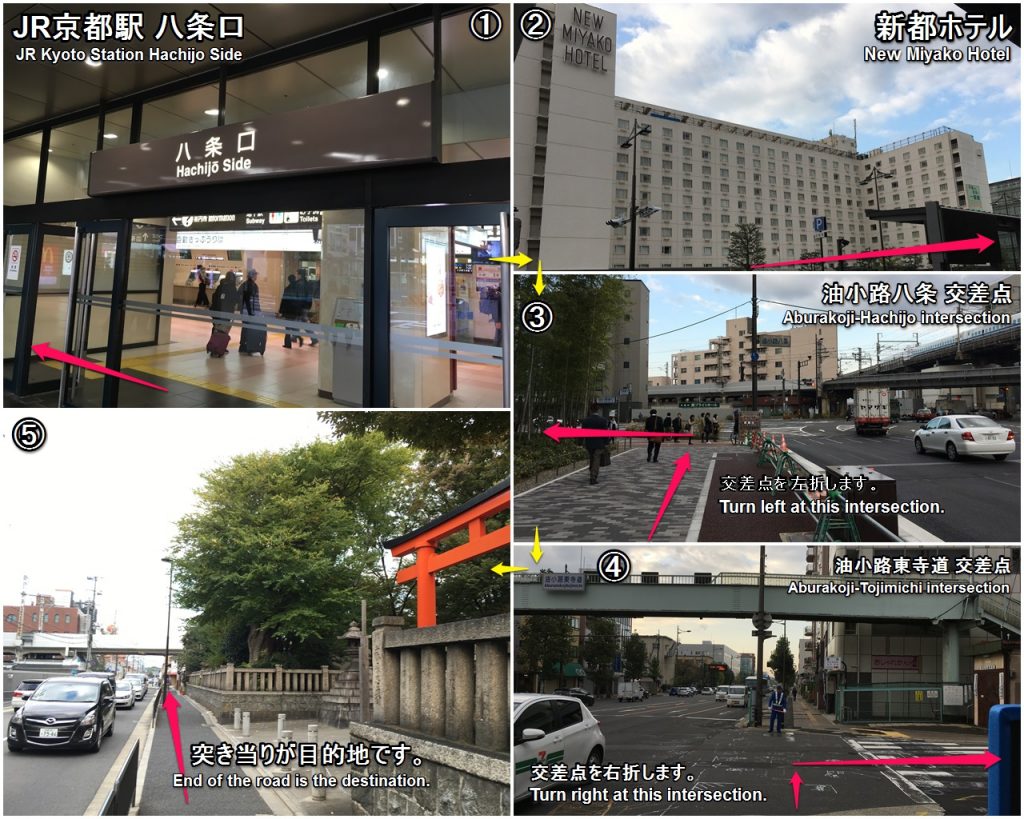
■When you go on foot from Kintetsu To-ji Station
It’s about 7 minutes (400 m) on foot.
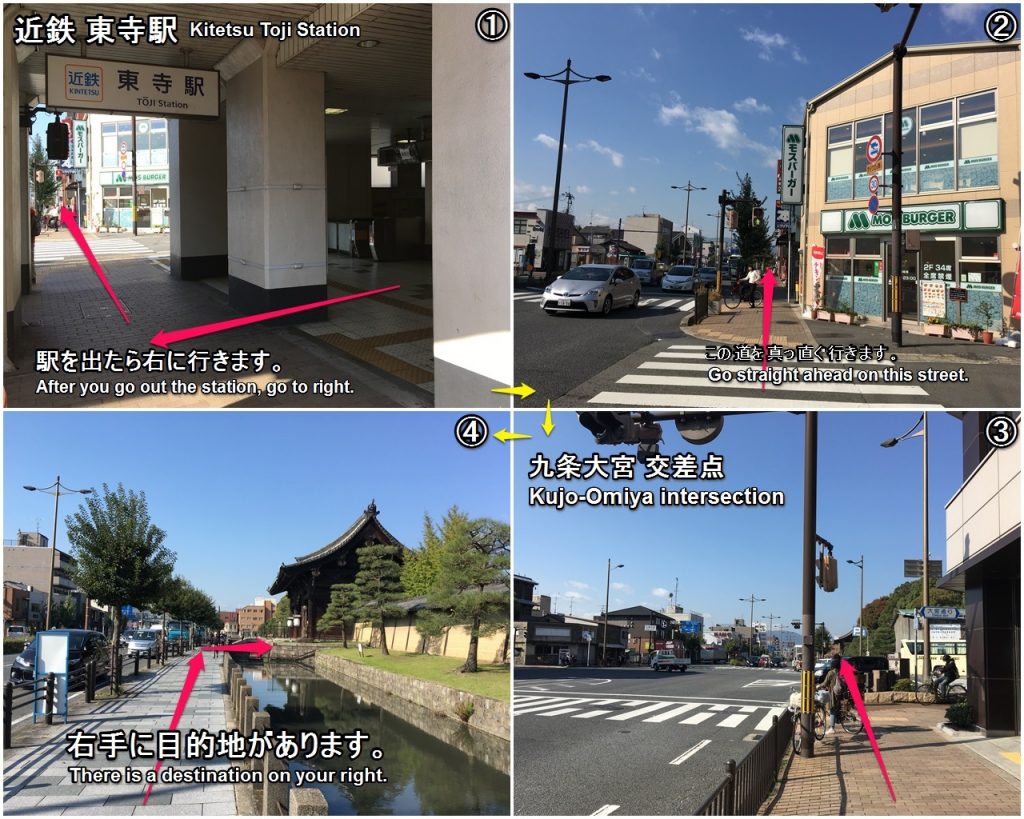
■When you get on a bus from JR Kyoto Station
Timetable and Route Search of bus
[Timetable]Route No.16
Bus company:Kyoto City Bus
Routes/Destination:No.16[Bound for Toji Temple]
Boarding bus stop:Kyoto Sta.[C4]
Alighting bus stop:Toji Nishimon-mae
Bus fare:230 yen
Time required:About 14 min
■When you get on a bus from JR Kyoto Station(Hachijoguchi)
Timetable and Route Search of bus
[Timetable]Route No.16
Bus company:Kyoto City Bus
Routes/Destination:No.16[Bound for Toji Temple]
Boarding bus stop:Kyoto Sta. (Hachijoguchi)[G1]
Alighting bus stop:Toji Nishimon-mae
Bus fare:230 yen
Time required:About 7 min
■When you get on a bus from Hankyu Kawaramachi Station
Timetable and Route Search of bus
[Timetable]Route No.207
Bus company:Kyoto City Bus
Routes/Destination:No.207[Bound for Toji Temple Via Shijo Omiya]
Boarding bus stop:Shijo Kawaramachi[D]
Alighting bus stop:Toji Higashimon-mae (Toji Temple)
Bus fare:230 yen
Time required:About 22 min
■When you get on a bus from Keihan Gion-Shijo Station
Timetable and Route Search of bus
[Timetable]Route No.207
Bus company:Kyoto City Bus
Routes/Destination:No.207[Bound for Toji Temple Via Shijo Omiya]
Boarding bus stop:Shijo Keihan-mae[B]
Alighting bus stop:Toji Higashimon-mae (Toji Temple)
Bus fare:230 yen
Time required:About 25 min
■When you take a taxi
From Kyoto Station:850 yen ~ 960 yen (about 10 minutes)
From Gion-Shijo Station:1,730 yen ~ 2,000 yen (about 15 minutes)
・Let’s show a taxi driver the following phrase.

・If you want to call a taxi, let’s show the following phrase.

[Phone number of taxi dispatch : Around the Kyoto Station]*Japanese text only.
9.Hotel search & reservation around To-ji Temple
How did you like it?
Please try to go.
Have a nice trip! XD
<Let’s search the sightseeing information of Kansai in Japan on ‘Japan’s Travel Manual‘!!>
<This site introduces the easiest way to get Japanese (Kansai) sightseeing spots to you.>

